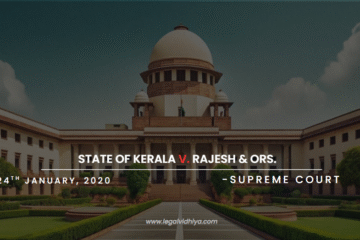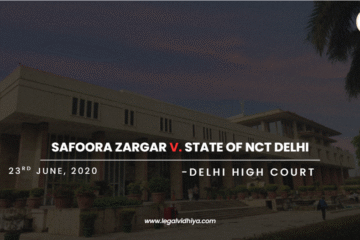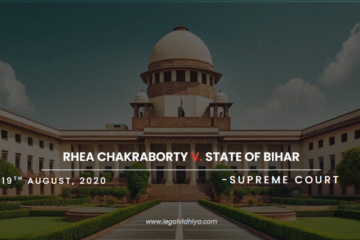
| CITATION | (2019) 2 SCC 743 |
| DATE OF JUDGMENT | January 2, 2019 |
| COURT | Supreme Court of India |
| APPELLANT | Management of the Barara Cooperative Marketing-Cum-Processing Society Limited |
| RESPONDENT | Workman Pratap Singh |
| BENCH | Abhay Manohar Sapre and Indu Malhotra, JJ. |
INTRODUCTION
This appeal has been filed by the Appellant, being aggrieved by the Judgment and Order rendered by the Division Bench of the Hon’ble High Court of Punjab and Haryana. The key issue before the Hon’ble Supreme Court pertains to whether the Respondent has a right to re-employment at the Appellant’s service, in accordance with the provisions set forth in Section 25-H of the Industrial Disputes Act (1947).
FACTS OF THE CASE
The Respondent was employed as a peon in the service of the Appellant since 1st July, 1973. On 1st July, 1985, the Appellant terminated the Respondent’s employment.
The Respondent challenged the termination before the Labour Court. The Labour court, by their order dated 3rd February, 1988, deemed the Respondent’s termination as unlawful and awarded a lump sum compensation of Rs 12,500/- to the Respondent in lieu of reinstatement to his service.
The Appellant and Respondent, both aggrieved by the order of the Labour Court, initiated Writ proceedings before the Hon’ble High Court. The Hon’ble High Court dismissed both Writ Petitions and upheld the Labour Court’s decision. They therefore accepted the compensation awarded by the Labour Court.
In the year 1993, the Respondent requested the Appellant to reinstate him as per the resolution dated 2nd August, 1993, by relying on Section 25-H of the Industrial Disputes Act, 1947.
The Appellant refused the Respondent’s request and the Respondent yet again approached the Labour Court, to determine whether the Respondent is indeed eligible for re-employment under Section 25-H of the Industrial Disputes Act, 1947. The Labour Court ruled in favour of the Appellant.
The Respondent challenged this decision of the Labour Court by filing a Writ Petition in the Hon’ble High Court. The Single bench of the High Court ordered in favour of the Respondent and directed his reinstatement as a peon in the Appellant’s service.
Dissatisfied, the Appellant employer pursued an appeal before the Hon’ble Division Bench. The Hon’ble Division Bench, dismissed the appeal and affirmed the Single Judge’s ruling.
Therefore, the Appellant has preferred the present Appeal.
ISSUE RAISED
Whether the Respondent is entitled to a right to re-employment in the Appellant’s service, in accordance with the provisions set forth in Section 25-H of the Industrial Disputes Act (1947)?
RATIONALE FOR DECISION
The Hon’ble Court observed that since the Respondent had accepted the compensation awarded in lieu of his reinstatement in service, he had put an end to the dispute.
The Hon’ble Court further contended that Section 25-H of the Industrial Dispute Act does not find relevance or applicability in the present case.
Section 25-H of the Industrial Disputes Act pertains to situations in which an employer intends to hire individuals to fill vacant positions within their organization. During this process, the employer is obligated to afford the “retrenched workman” the opportunity for re-employment. If the retrenched workman expresses interest in being re-hired, they shall be accorded priority over other Applicants who have applied for the advertised job vacancy. Section 25-H of the Industrial Disputes Act mandates compliance in accordance with the stipulated procedure delineated in Rule 78 of the Industrial Disputes (Central) Rules, 1957. This rule unequivocally establishes the applicability of Section 25-H solely in situations where the employer intends to replenish vacancies within their establishment through the recruitment of individuals. It further outlines the requisite issuance of a notice to the retrenched employees as prescribed within the aforementioned rule.To trigger the application of Section 25-H of the Industrial Disputes Act, the workman must substantiate two key elements. Firstly, they must establish their status as a “retrenched employee.” Secondly, it must be demonstrated that their former employer has made a decision to fill vacancies within their establishment. Consequently, the workman is entitled to assert a preference over individuals who have applied for re-employment in the services in relation to those vacancies.
The Hon’ble Court opined that in the present matter, the Respondent’s termination was deemed unlawful, resulting in the issuance of a lump-sum compensation of Rs 12,500/- as a final resolution. It remains uncontested that the Respondent willingly accepted said compensation. Accordingly, it is evident that this situation does not fall within the purview of a retrenchment, as delineated under Section 25-H of the Industrial Disputes Act.
The Hon’ble Court further noted that the Respondent lacks the entitlement to invoke provisions of Section 25-H of the Industrial Disputes Act, since his condition is not the same as the other two employees (peon) whose case he relied on. The other two employees were already employed with the Appellant and their employment was solely regularised by the Appellant based on the employee’s service history in accordance with the established regulations. The act of regularising an employee already in service does not confer any entitlement upon a previously retrenched employee to invoke Section 25-H of the Industrial Disputes Act for the purpose of claiming re-employment within the organisation’s services. The fact that the employer, through such an action, is not extending a fresh employment offer to fill a vacant position within their establishment but are merely formalising the employment status of an existing employee. Such an action does not constitute the filing of any vacancy.
The Hon’ble Court has judiciously distinguished between the terms “employment” and “regularisation of service.” The term “employment” conveys the notion of initiating fresh employment to address vacant positions, while “regularisation of service” denotes the process by which the services of an individual who is already employed are regularised in accordance with the established service regulations.
The Hon’ble Court duly noted that the Labour Court’s decision to rule in favour of the Appellant and against the Respondent, by correctly determining that Section 25-H of the Industrial Disputes Act had no relevance to the circumstances at hand, was justifiable. Conversely, the High Court, both at the Single Judge and Division Bench levels, were not right in granting the respondent’s plea for reinstatement as a peon with the appellant.
JUDGEMENT
The Hon’ble Supreme Court, having duly considered the matter, has decreed that the appeal is meritorious. Consequently, the order of the Hon’ble High Court is set aside and the award of the Labor Court is restored.
CONCLUSION
The Hon’ble Supreme Court has carefully examined the appeal brought before it and after thorough consideration of the facts and legal provisions, the Court has determined that the Respondent’s acceptance of compensation in lieu of reinstatement marked the final resolution of the matter and thereby renders Section 25-H of the Industrial Disputes Act irrelevant to the case. The Court clarified that Section 25-H applies in situations involving the recruitment of new employees to fill vacancies, not the regularisation of existing employees’ services.
REFERENCE
- SCC Online
This Article is written by Raj Nagre student of New Law College, Mumbai; Intern at Legal Vidhiya.




0 Comments